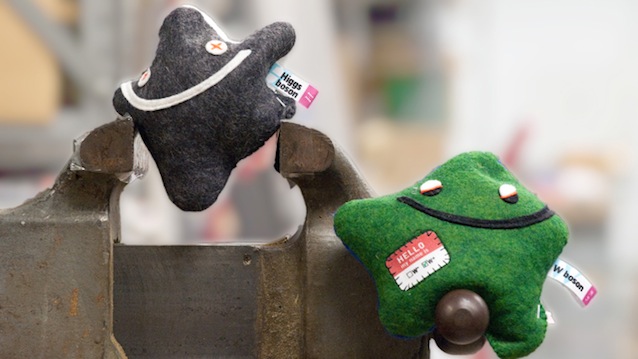EVANSTON, Ill. --- Northwestern University high-energy physics students played a significant role in the world’s most precise measurement of the mass of the W boson, a result announced March 2 by the Department of Energy’s Fermi National Accelerator Laboratory.
The W boson is one of nature’s elementary particles. Knowing its mass -- 80.387 giga electron volts, or GeV, plus or minus 0.019 GeV -- will help in the hunt for the Higgs boson, one of the great mysteries of the universe.
The Higgs boson is a hypothetical elementary particle predicted by the Standard Model of particle physics. Physicists now are very close to finding out whether or not the Higgs does exist, with recent evidence indicating that the end of the biggest manhunt in the history of physics might finally be in sight.
The Northwestern contribution to the W boson measurement is part of Professor Heidi M. Schellman’s program of precision measurements of the weak interactions between particles. She is a professor of physics and astronomy and chair of the department in the Weinberg College of Arts and Sciences.
“This new measurement helps squeeze the possible masses of the elusive Higgs into a tighter area than before,” she said. “We have measured the mass of the W boson with a precision of two parts in 10,000 and that gives us a hint that the Higgs boson mass lies well below 150 GeV.”
While Schellman’s group has helped show the Higgs is likely to be cornered soon, her high-energy physics colleagues Michael Schmitt and Mayda Velasco are hot on the trail of the Higgs at the Large Hadron Collider at CERN in Geneva, Switzerland, while theoretical colleagues Frank Petriello and Ian Low have played a major role in predicting where and how to look for the Higgs boson.
Measuring particle masses very precisely, like the W boson, can tell scientists about objects not yet discovered. Similar to astronomers discovering a faint planet by observing its gravitational influence on visible objects, new particles can subtly change the characteristics of more familiar ones in ways that tell scientists about new physics before it can be produced directly.
The W boson measurement was the product of two competing teams from the DZero and CDF collaborations at Fermilab. They made their measurements using Fermilab’s Tevatron Collider, a circular particle accelerator that was shut down last year.
Each team has around 400 scientists from dozens of institutions worldwide. The DZero W mass collaboration includes Schellman’s group at Northwestern and groups at the University of Maryland, Mississippi State University and SUNY Stony Brook, all in the U.S., and groups from Lyons, Grenoble and Paris Sud in France.
Schellman’s graduate students Timothy Andeen and Sahal Yacoob made major contributions to this effort. Both have now graduated. Andeen is now a postdoctoral fellow at Columbia University after a fellowship at CERN. Yacoob is a postdoctoral fellow at the University of the Witwatersrand in South Africa and will be moving to a lecturership at the University of KwaZulu Natal later this year.
Measuring fundamental quantities with this level of precision is very difficult, Schellman explained. Experimental apparatuses have flaws that must be carefully compensated in order to squeeze out the last bit of accuracy. But what happens when you are measuring a well-known quantity, such as the W boson mass?
“If you see a different value, you may blame the detector and study your calibrations more carefully,” Schellman said. “But if you don’t see a difference you may not examine that calibration as carefully. This can introduce subtle biases into the measurement, and we have to be very careful to avoid them, especially when our goal is such a precise number.”
To avoid unconscious bias, the DZero and CDF groups both used a technique called blinding, similar in philosophy to the double-blind standard in clinical trials. They added a fixed but unknown offset to the measured mass in their data analysis programs so they could not know if any given correction was pushing the result toward or away from the previously measured value. The entire analysis of the data was completed and reviewed thoroughly by other collaborators before the secret constant was revealed to the group.
“In the case of DZero, the revelation was done only three days before the result went public,” Schellman recalled.
For more information on the W boson measurement, go to Fermilab's website.


